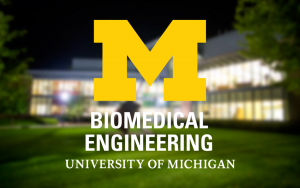Presented By: Biomedical Engineering
Master's Thesis Defense: Mingyang Wang
Removing Skin Microvessels Using Photo-Mediated Ultrasound Therapy

NOTICE: This event will be held via Blue Jeans. It will be linked before.
BlueJeans: https://bluejeans.com/315155702
Objectives
We have developed a novel anti-vascular technique, termed photo-mediated ultrasound therapy (PUT), which utilizes nanosecond duration laser pulses synchronized with ultrasound bursts to remove microvasculature through cavitation. The objective of the current study is to explore the potential of PUT in removing cutaneous microvessels.
Methods
The auricular blood vessels of two New Zealand white rabbits were treated by PUT with a peak negative ultrasound pressure of 0.45 MPa at 0.5 MHz, and a laser fluence of 0.056 J/cm2 at 1064 nm for 10 minutes. Blood perfusion in the treated area was measured by a commercial laser speckle imaging (LSI) system before and immediately after treatment, as well as at one hour, three days, two weeks, and four weeks post treatment. Perfusion rates of 38 individual vessels from 4 rabbit ears were tracked during this time period for longitudinal assessment.
Results
The measured perfusion rates of the vessels in the treated areas, as quantified by the relative change in perfusion rate (RCPR), showed a statistically significant decrease for all time points post treatment (p<0.001). The mean decrease in perfusion is 50.79% immediately after treatment and is 32.14% at four weeks post treatment. Immediately after treatment, the perfusion rate decreased rapidly. Following this, there was a partial recovery in perfusion rate up to 3 days post treatment, then followed by a plateau in the perfusion from 3 days to 4 weeks.
Conclusions
The study demonstrated that a single PUT treatment could significantly reduce blood perfusion by 32.14% in the skin for up to 4 weeks. With unique advantages such as low laser fluence as compared with photothermolysis and agent-free treatment as compared with PDT, PUT holds potential to be developed into a new tool for the treatment of microvessels in the skin.
Keywords: laser; ultrasound; anti-vascular treatment; skin microvessels; photo-mediated ultrasound therapy
Chair: Dr. Xueding Wang
BlueJeans: https://bluejeans.com/315155702
Objectives
We have developed a novel anti-vascular technique, termed photo-mediated ultrasound therapy (PUT), which utilizes nanosecond duration laser pulses synchronized with ultrasound bursts to remove microvasculature through cavitation. The objective of the current study is to explore the potential of PUT in removing cutaneous microvessels.
Methods
The auricular blood vessels of two New Zealand white rabbits were treated by PUT with a peak negative ultrasound pressure of 0.45 MPa at 0.5 MHz, and a laser fluence of 0.056 J/cm2 at 1064 nm for 10 minutes. Blood perfusion in the treated area was measured by a commercial laser speckle imaging (LSI) system before and immediately after treatment, as well as at one hour, three days, two weeks, and four weeks post treatment. Perfusion rates of 38 individual vessels from 4 rabbit ears were tracked during this time period for longitudinal assessment.
Results
The measured perfusion rates of the vessels in the treated areas, as quantified by the relative change in perfusion rate (RCPR), showed a statistically significant decrease for all time points post treatment (p<0.001). The mean decrease in perfusion is 50.79% immediately after treatment and is 32.14% at four weeks post treatment. Immediately after treatment, the perfusion rate decreased rapidly. Following this, there was a partial recovery in perfusion rate up to 3 days post treatment, then followed by a plateau in the perfusion from 3 days to 4 weeks.
Conclusions
The study demonstrated that a single PUT treatment could significantly reduce blood perfusion by 32.14% in the skin for up to 4 weeks. With unique advantages such as low laser fluence as compared with photothermolysis and agent-free treatment as compared with PDT, PUT holds potential to be developed into a new tool for the treatment of microvessels in the skin.
Keywords: laser; ultrasound; anti-vascular treatment; skin microvessels; photo-mediated ultrasound therapy
Chair: Dr. Xueding Wang